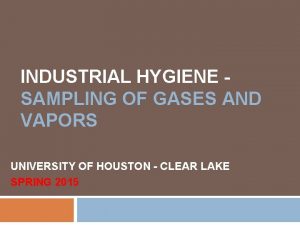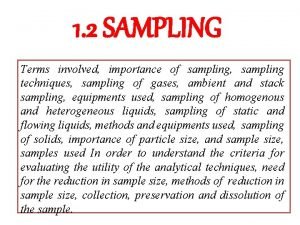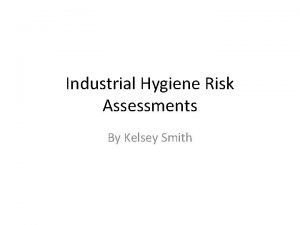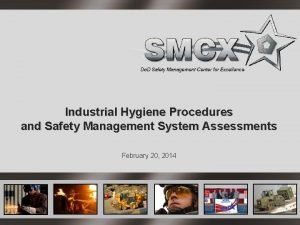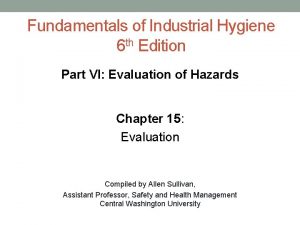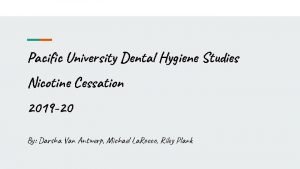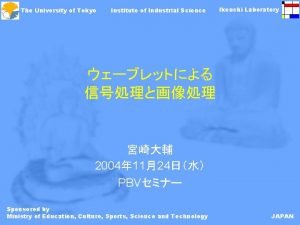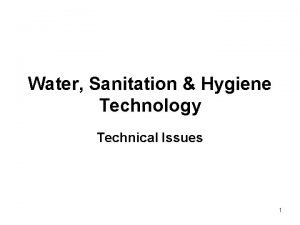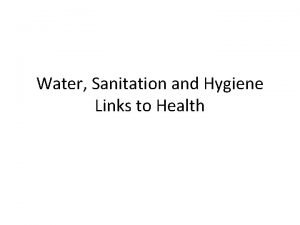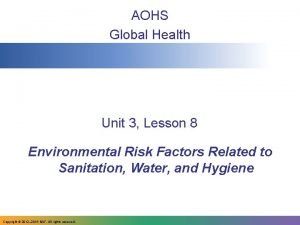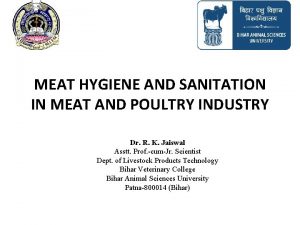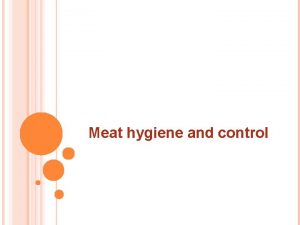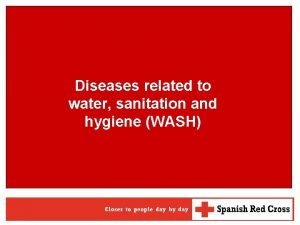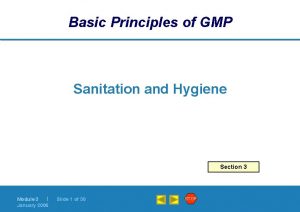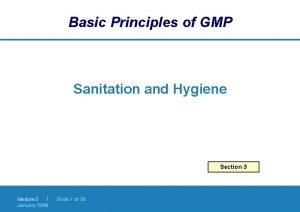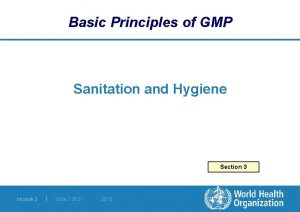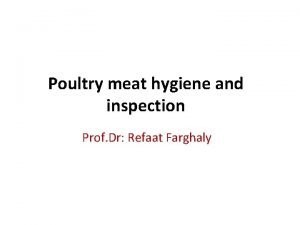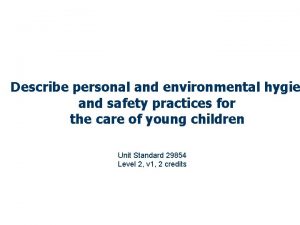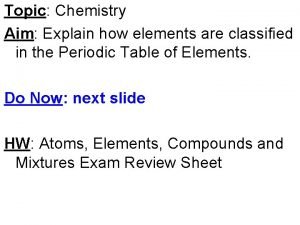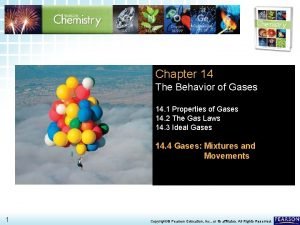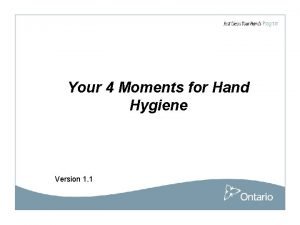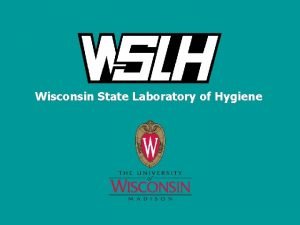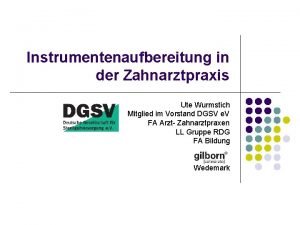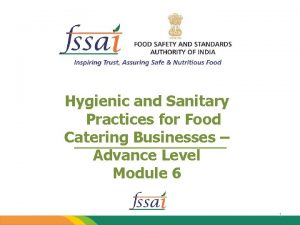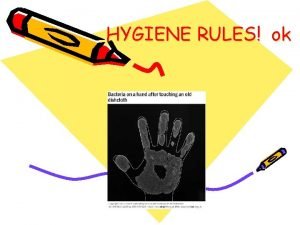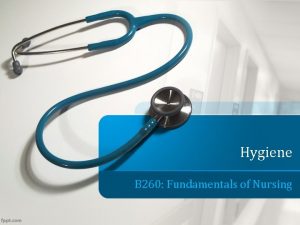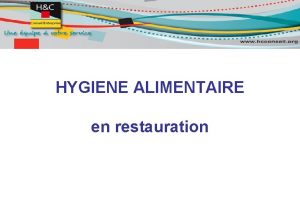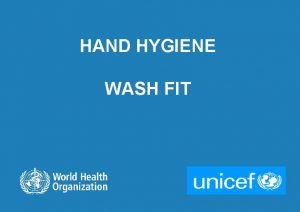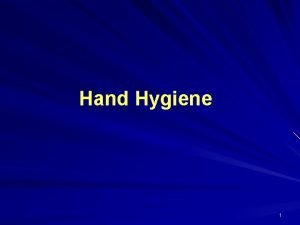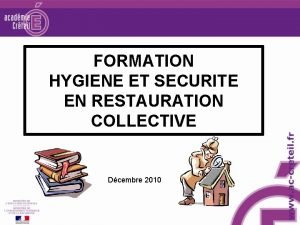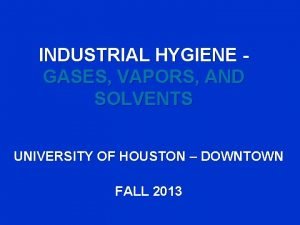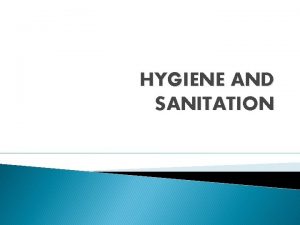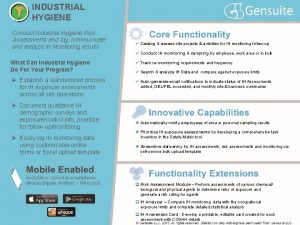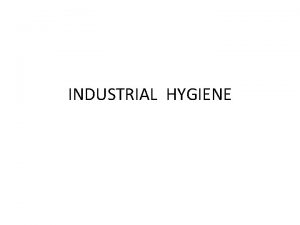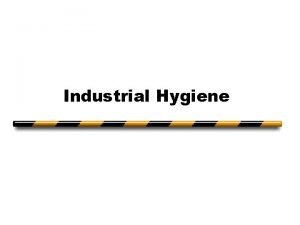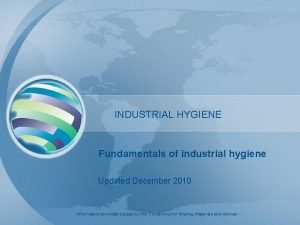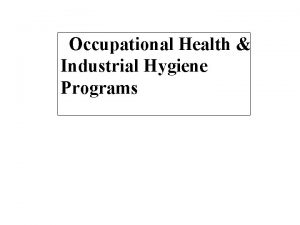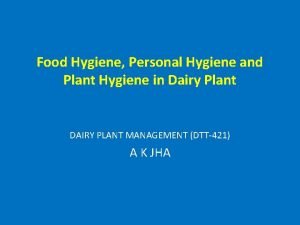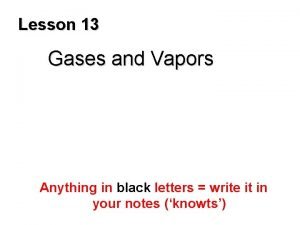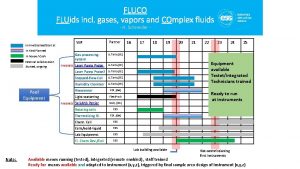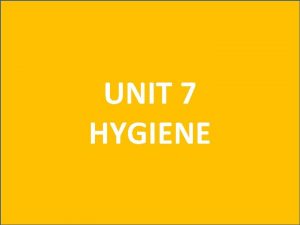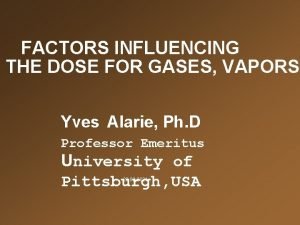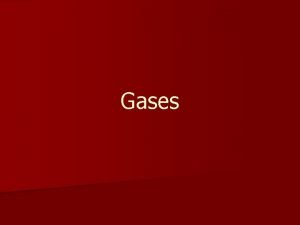INDUSTRIAL HYGIENE SAMPLING OF GASES AND VAPORS UNIVERSITY































































- Slides: 63

INDUSTRIAL HYGIENE SAMPLING OF GASES AND VAPORS UNIVERSITY OF HOUSTON - CLEAR LAKE SPRING 2015

PURPOSE Introduce techniques to evaluate EXPOSURES to gases and vapors arising in or from the workplace. Additionally: - be aware of technology for assessment of environments; - indoor and ambient air; and, - capabilities and limitations of various referenced methods.

SAMPLING GASES AND VAPORS When developing a sampling strategy, review available sampling and analytical methods for contaminants of interest. Select most suitable! e. g. OSHA, NIOSH i. e. published and validated methods. EPA methods used for lower level indoor air pollutants and toxics in ambient air.

SAMPLING METHOD Select a method that meets sampling and analytical ACCURACY and PRECISION requirements of the referenced standard in unique field conditions. Usually stipulate measurement at the PEL within +/- 25% of the “true” value at a 95% confidence level. EPA – related to ambient air.

ANALYTICAL LABORATORY Select and consult with qualified analytical laboratory, e. g. AIHA for participation in appropriate Laboratory Accreditation Programs. Labs assist with method choice that meet sensitivity and specificity criteria for environment under evaluation. Choose sampling media and strategy compatible with method and review special handling. Two key factors: knowledge of occupational environment AND overall perspective of the limitation of the chemistry of sampling/analysis parameters.

SENSITIVITY Exercise caution when using traditional workplace sampling method for measuring contaminants in indoor or ambient air because expected concentrations may be below the working range. To obtain sensitivity, NIOSH recommends exceeding recommended air volume while observing the suggested maximum flow rate. The conservative value protects against breakthrough (e. g. primary vs. back-up sections of sampler) under “worst-case” conditions of high %RH and/or concentrations.

GAS/VAPOR For IH purposes, a substance is a GAS if this is normal physical state at room temperature (25 degrees C) and one-atmosphere pressure. Examples: CO, Cl, Oxygen, and Nitrogen. If substance is normally a liquid at normal temperature and pressure, then the gaseous component in equilibrium with liquid state is a VAPOR. Examples: CCl 4, HCOH, and Benzene.

SAMPLING PLAN Designing a sampling plan involves consideration of the following: location of samples, number of workers, and duration of sampling. Also other factors: noise, equipment, size, flow rate, and security of equipment/sample integrity.

SAMPLE TYPES Two basic types of samples used to assess employee exposure: - Integrated - Grab.

INTEGRATED SAMPLING For gases and vapors, passage of a known volume of air through an ABsorbing or ADsorbing medium to remove the desired air contaminants during defined time period. Absorb – penetration into material; physically dissolve or chemically react with sample medium. Adsorb – traps airborne chemicals onto surface. Contaminants of interest are collected and concentrated over time to obtain the average

GRAB SAMPLING Direct collection of an air-contaminant mixture into a device (i. e. sampling bag, syringe, or evacuated flask) over a short interval of a few seconds or minutes. Represents the atmospheric concentrations at the sampling site at a given point in time.

WHOLE AIR SAMPLING Collection of air into a sealable container (e. g. stainless steel canister or sampling bag) for subsequent analysis. Example: Figure 11. 10 [insert – follows] Obtained over a short period of time as grab samples OR integrated over a longer period of time to obtain Time-Weighted Average (TWA).

INTEGRATED SAMPLING Cover the entire period of exposure required because airborne contaminant concentrations during a typical work shift vary with time and activity! Grab samples do not reflect average exposures. Most integrated sampling is done to determine the 8 -hour TWA and/or STELs for comparison with OSHA PELs, ACGIH TLVs and NIOSH RELs.

Personal Pocket Sampling Pump

INTEGRATED SAMPLING CONSIDERATIONS Appropriate sample duration and flow rate chosen relative to the purpose of sampling, sensitivity of analytical method, and expected concentration of contaminant. Accurate measurement of flow rate and time which depends on precise determination of the mass of contaminant collected and volume of air sampled.

ACTIVE SAMPLING Means of collecting an airborne substance with a mechanical device such as air sampling pump to draw the air/contaminant mixture into or through the sampling device. Examples: sorbent tube, treated filter, or impinger containing a liquid media. A key element is calibration that reliably measures the pump flow rate, thus allowing for an accurate determination of air volume.

ACTIVE SAMPLING Uses mechanical device to collect airborne substance such as air sampling pump to draw the air/contaminant mixture into or through the sampling device.

AIR SAMPLING PUMPS Integrated methods require relatively constant source of suction calibrated to recommended flow rate (within +/- 5% with collection media inline).

AIR SAMPLING WITH PUMPS Personal sampling (i. e. breathing zone) OR area sampling for potential source(s). Features – constant flow capabilities/back pressure; intrinsically safe; etc. Maintain desired flow rate over the entire sampling period with in-line sample collection device. Pressure drop; constant flow vs. constant pressure

CALIBRATION Pump flow must be calibrated with the entire sampling train assembled as used. Good IH practice requires both pre- and postpump calibration on the same day under pressure and temperature conditions similar to those at site. Not addressed with built-in rotameters (not precision devices and do not provide a quantitative measure of the airflow).

CALIBRATION STANDARDS Two Terms: Primary – direct and measurable linear dimensions (length and diameter of cylinder). � Examples: spirometers and bubble meters Secondary – flowmeters that trace calibration to primary standards and maintain accuracy with reasonable care and handling in operation. � Examples: precision rotameters, wet test meters, and dry gas meters Refer to instructions from manufacturers.

SAMPLE COLLECTION MEDIA Consult published air sampling methods to determine the appropriate collection media for a specific chemical contaminant. Review methods to determine applicability relative to field conditions. Such as: VP, BP, reactivity; interferences, also humidity/temperature effects, proper measuring range; physical state of the contaminant sampled; multiple phases (i. e. particulate and vapor, etc. ).

ACTIVE SAMPLING – ADVANTAGES - Select method used by compliance personnel during OSHA inspection. - Offers calibrated, measured airflow for assurance in accuracy of sample volume. - Sorbent tube samples have a secondary layer for back-up indicating break-through. - Multiple phases can be assessed by a series of samplers.

ACTIVE SAMPLING – DISADVANTAGES - Cumbersome equipment and may job interfere with personnel. - Pump calibration is time consuming and requires technical training. - Pump may become somewhat less reliable maintaining entire at the constant over flow sampling period, and more frequent calibration may be necessary.

PASSIVE SAMPLERS Passive sampling is the collection of airborne gases and vapors at a rate controlled by a physical process such as diffusion through a static air layer or permeation through a membrane without the active movement of air through sampler. Operate on principle of diffusion.

Organic Vapor Monitoring Badges

PASSIVE SAMPLERS Performance characteristics evaluated in the NIOSH Validation Protocol include: - Analytical recovery - Sampling rate and capacity - Reverse diffusion - Storage stability - Analyte concentration - Exposure time - Face velocity

PASSIVE SAMPLERS Performance characteristics evaluated in the NIOSH Validation Protocol include: - Relative humidity - Interferences - Monitor orientation - Temperature - Accuracy and precision - Shelf life - Behavior in field

DIFFUSIVE SAMPLERS Rely on movement of contaminant molecules across a concentration gradient, which for steady-state conditions can be defined by: Fick’s first law of diffusion. Consist of diffusion gap between external air and a sorbing medium to collect chemicals of interest, but also to maintain the concentration as close to zero as possible at the end of the diffusion path.

DIFFUSIVE SAMPLERS Each gas/vapor sampled has a specified diffusion coefficient (D). Uptake rates can vary under various field conditions. Validation! See Equations and Units on Page 274 (Third Edition).

OSHA ISSUES Report (1998) attempted to determine sampling rate variation of specific passive sampler designs. Concept of passive sampling equated to active sampling with pump error of +/- 5%. Significant - use of sampling rate variation for passive sampler along with the analytical error component allowed calculation of the overall Sampling and Analytical Error (SAE). SAE must be used by OSHA inspectors along with sample results to determine if PEL exceeded. Therefore, passive sampling methods can be used by OSHA.

PASSIVE SAMPLERS Various types are commercially available. Some samplers designed to collect broad range of compounds, whereas others due to collection media preferentially obtain a single chemical or family of chemicals. Examples: activated charcoal sorbent – organic vapors and GC analysis; chemical treated sorbents or filter paper for HPLC analysis. Direct-reading passive samplers based on colorimetric techniques; may not be accurate as lab analytical methods. as

PASSIVE SAMPLING – ADVANTAGES - Easy to use, samples can be collected by personnel with less technical training. - Less expensive. - Less obtrusive for wearer. - For most applications, the mass of contaminant collected passive by samplers is not significantly affected by temperature or pressure.

PASSIVE SAMPLING – DISADVANTAGES - May not be OSHA/NIOSH methods referenced in order to insure reliability of data. - Sampling rate, if theoretically calculated, may not prove valid under field conditions. - Reverse diffusion may be a factor. - Environmental parameters may influence lection y the samplers. Examples: stagnant air; high face velocities. - Low uptake rates may not provide vel for sensitivity required

GRAB SAMPLING Collected sample measures gas and vapor concentrations AT A POINT IN TIME and used to evaluate “PEAK” exposures for comparison to “Ceiling” limits. Identify unknown contaminants, evaluate contaminant sources, or measure contaminant levels from intermittent processes/other sources. Collected using syringes, canisters, or bags, etc. Instantaneous (as well as integrated) measurements of gases/vapors also may be performed using detector tubes or direct-

Colorimetric Tubes and Sampling Pump

Colorimetric Gas Detection Tubes

GRAB SAMPLING – ADVANTAGES - - After collection, frequently analyzed immediately by GC or direct-reading instruments. Therefore, quick decisions made in field/site about source of leaks; Confined Space Entry (CSE); PPE, etc.

GRAB SAMPLING – DISADVANTAGES - For most applications, contaminants are collected but not integrated over time. Only some devices will allow use of a metering device to collect sample(s) at or near constant flow over period of time for TWA. - For low contaminant concentrations, analytical instrument may sensitive not be for detection. - Multiple grab samples to assess full-shift exposures is time-consuming process and subject to error.

OPERATIONAL LIMITS OF SAMPLING AND ANALYSIS Inherent limitations of method: - Sampler capacity - Limit of Detection (LOD) - Limit of Quantification (LOQ) - Upper measurement limits define useful range of referenced method. These factors determine the minimum, maximum, or optimum volume of air to be sampled and also confidence that can be placed in the results. Discuss with lab before sampling!

SAMPLER CAPACITY Predetermined conservative estimate of total mass of contaminant that can be collected on medium without loss or overloading. NIOSH definition of 2/3 of experimental breakthrough capacity of the solid sorbent [i. e. 67% of mass of contaminant on sorbent at the break -through volume]. Break-through volume is: volume of an atmosphere containing two times the PEL for the contaminant that can be sampled at the recommended flow rate before the efficiency of the sampler degrades to 95%.

LIMIT OF DETECTION (LOD) Lowest concentration level determined to be statistically different from a blank sample. Recommended value of the LOD is the amount of analyte that will give rise to a signal that is three times the standard deviation of the signal derived from the media blank.

LIMIT OF QUANTIFICATION (LOQ) Concentration level above which quantitative results may be obtained with a certain confidence. Recommended value of the LOQ is the amount of analyte that will give rise to a signal that is ten times the standard deviation of the signal from a series of media blanks. Corresponds to a relative uncertainty in the measurement of +/- 30% at 99% confidence level.

DETECTION LIMIT (DL) Described both in terms of: - DL of the analytical procedure, and - DL of the overall procedure. OSHA reports, in general, that detection limits (DL) are defined as: amount of analyte that gives a response that is significantly different (three SD) from the background response.

UPPER MEASUREMENT LIMIT Useful limit of the analytical instrument (mg of analyte per sample). Sample above Upper Measurement Limit, then re-dilute and re-analyze. Review and discuss with analytical lab.

TARGET CONCENTRATION Preliminary estimate of airborne contaminant concentration relative to the purpose of testing. Parameter can be used to determine the minimum and maximum air volumes. Can be estimated by: using previous sampling data, use of direct-reading instruments, or by relying on the professional judgment of the IH.

CALCULATIONS Sample volumes – minimum and maximum. Working range is range of contaminant concentration that may be quantitated at a specified air volume. Lower boundary of working range is defined by a sample that has a mass of contaminant equal to the LOQ. Upper boundary is defined by sampler capacity. Refer to Page 278 (Third Edition) formulas.

SOLID SORBENT MEDIA Adsorb onto surface; Effectiveness determined by: Trap and retain nearly all contaminants from air Amenable to desorption from sorbent Sufficient capacity to retain contaminant quantity for analysis without large media pressure drop Not cause chemical change of contaminant except by analytical method as needed Absorb contaminant of interest in presence of other substances, possibly in higher concentrations than necessary for compound.

COLLECTION EFFICIENCY OF SOLID SORBENTS Various Factors: Temperature Humidity Sampling Rate Other Contaminants Sample Break-through - 25% - Migration

DESORPTION - Solvent extraction - extract contaminants of interest from adsorbent materials. Examples: carbon disulfide; mixtures. - Thermal desorption – drive contaminant sorbent off high temperature; by entire mass duced yminant of analyticalinstrument without dilution; and, measure low airborne concentrations.

DESORPTION EFFICIENCY Measure of how much analyte can be recovered from the sorbent tube; determined typically at 0. 1, 0. 5, 1, and 2 times target concentration based on the recommended air volume and expressed as a percentage of analyte spike on media. To be determined for each lot number of solid sorbent used for sampling and also done in the concentration range of interest.

TYPES OF SORBENT MATERIALS Inorganic Sorbents – silica gel (polar; %RH); less reactive than charcoal Elemental Carbon – charcoal types; organics; high adsorptive capacity; stable compounds; high humidity parameters Carbonized or Graphitized Sorbents – low to moderate surface area; intermediate to high volatility; stable compounds for thermal desorption

Sorbent Tubes

Sorbent Tubes

TYPES OF SORBENT MATERIALS Organic Polymers - selectivity to particular applications, and stability at high temps enables thermal desorption (i. e. Tenax – broad range of organics can be collected). Other Sorbent Materials – sorbents with PUF; sorbent combinations; sorbent/filter combinations – OVS, etc.

Sorbent Tubes

OTHER MEDIA Chemically treated filters – derivatize/desorb Liquid absorbers � Gas washing bottles – e. g. impingers � Fritted glass bubblers

Filter Cassettes

Filter Cassettes

OTHER MEDIA Sampling bags/evacuated containers/canisters � Situations: - direct-reading instruments; leaks/emergencies; peaks; highly volatile compounds Precautions – storage time; reaction; diffusion.

CALCULATIONS Total Mass of Contaminant Airborne Concentration by sample volume (mass over volume) Air Volume (flow rate x sample time) Unit Conversions – mg/M 3 to/from ppm Temperature/Pressure Corrections Time-Weighted Averages (TWA) Potential Work Shift Adjustments See Formulas and other Handouts/PPTs.

CALCULATIONS Unit Conversions – mg/M 3 to/from ppm Temperature/Pressure Corrections Time-Weighted Averages (TWA) Potential Work Shift Adjustments Formulas on Page 286 -287 (Third Edition).

REMEMBER CALCULATIONS Range of temperature and pressure changes tolerated before corrections are applied to the volume of air sampled. All OELs and environmental exposure standards and limits are expressed at 25 degrees C and 1 atmosphere (760 mm Hg), defined as normal temperature and pressure (NTP). Therefore, corrections needed for meaningful comparisons to published OELs.
 Wolf
Wolf Split-tube thief
Split-tube thief Industrial hygiene risk assessment
Industrial hygiene risk assessment Industrial hygiene procedure
Industrial hygiene procedure Fundamentals of industrial hygiene
Fundamentals of industrial hygiene Probability vs non probability sampling
Probability vs non probability sampling Panel sampling
Panel sampling Stratified versus cluster sampling
Stratified versus cluster sampling Perbedaan time sampling dan event sampling
Perbedaan time sampling dan event sampling Cluster vs stratified sampling
Cluster vs stratified sampling Quota sampling
Quota sampling Natural sampling vs flat top sampling
Natural sampling vs flat top sampling Pacific university dental hygiene
Pacific university dental hygiene Institute of industrial science the university of tokyo
Institute of industrial science the university of tokyo Sanitation and hygiene
Sanitation and hygiene Sanitation and hygiene
Sanitation and hygiene Personal grooming
Personal grooming Personal grooming
Personal grooming Unit 3 health and hygiene
Unit 3 health and hygiene Poultry hygiene and sanitation
Poultry hygiene and sanitation Meat hygiene
Meat hygiene Sanitation and hygiene
Sanitation and hygiene Gmp sanitation and hygiene
Gmp sanitation and hygiene Gmp sanitation and hygiene
Gmp sanitation and hygiene Basic principles of personal hygiene
Basic principles of personal hygiene Poultry meat hygiene and inspection
Poultry meat hygiene and inspection What is personal and environmental hygiene
What is personal and environmental hygiene Explain
Explain Expansion of solids liquids and gases examples
Expansion of solids liquids and gases examples Solids liquids and gases section 2 properties of fluids
Solids liquids and gases section 2 properties of fluids Conduction convection and radiation venn diagram
Conduction convection and radiation venn diagram Solid liquid and gas particles
Solid liquid and gas particles Molecular theory of gases and liquids
Molecular theory of gases and liquids Examples of solids liquids and gases pictures
Examples of solids liquids and gases pictures 14.4 gases mixtures and movements answers
14.4 gases mixtures and movements answers Lesson outline lesson 1 solids liquids and gases answer key
Lesson outline lesson 1 solids liquids and gases answer key Chapter 14 solids liquids and gases worksheet answers
Chapter 14 solids liquids and gases worksheet answers Kinetic molecular theory of liquids and solids
Kinetic molecular theory of liquids and solids Particle movement in solids liquids and gases
Particle movement in solids liquids and gases Unit 24 cutting with oxyfuels and other gases
Unit 24 cutting with oxyfuels and other gases Solid liquid and gases
Solid liquid and gases How does sound travel through solids liquids and gases
How does sound travel through solids liquids and gases Properties of solids liquids and gases
Properties of solids liquids and gases Motion of particles in solids, liquids and gases
Motion of particles in solids, liquids and gases 沈榮麟
沈榮麟 Public health ontario 4 moments of hand hygiene
Public health ontario 4 moments of hand hygiene Phinms
Phinms Reproductive hygiene
Reproductive hygiene Oefentoets svh
Oefentoets svh Pengertian resiko hygiene adalah....?
Pengertian resiko hygiene adalah....? Conclusion for hygiene
Conclusion for hygiene Hygiene jeopardy
Hygiene jeopardy Targeted solutions tool
Targeted solutions tool Instrumentenaufbereitung in der zahnarztpraxis
Instrumentenaufbereitung in der zahnarztpraxis Modified pen grasp in dentistry
Modified pen grasp in dentistry Personal hygiene in catering
Personal hygiene in catering Kitchen hygiene rules
Kitchen hygiene rules Objectives of hygiene promotion
Objectives of hygiene promotion How to wash a bedridden patients hair
How to wash a bedridden patients hair Prévention des tiac en restauration collective
Prévention des tiac en restauration collective What is health education definition
What is health education definition Hand hygiene objectives
Hand hygiene objectives Optimum hand hygiene steps
Optimum hand hygiene steps Hygiène et sécurité en restauration collective
Hygiène et sécurité en restauration collective
